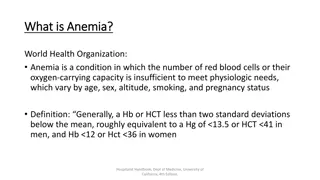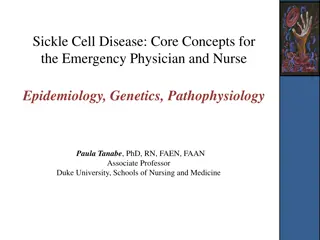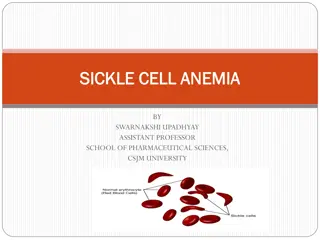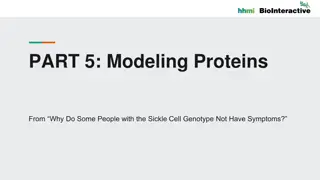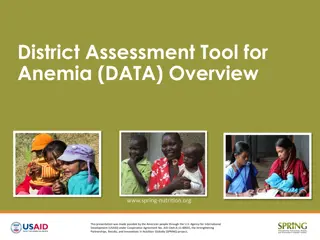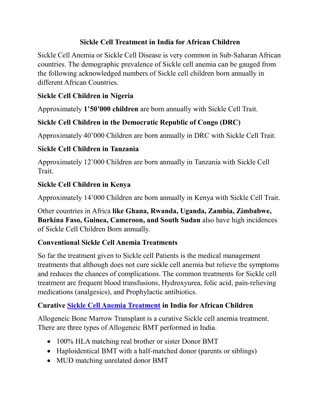Comprehensive Guide to Sickle Cell Anemia
Sickle cell anemia, an inherited disorder, affects red blood cells' shape and oxygen distribution in the body. Learn about its causes, symptoms, diagnosis, treatment, and prevention strategies.
Download Presentation

Please find below an Image/Link to download the presentation.
The content on the website is provided AS IS for your information and personal use only. It may not be sold, licensed, or shared on other websites without obtaining consent from the author.If you encounter any issues during the download, it is possible that the publisher has removed the file from their server.
You are allowed to download the files provided on this website for personal or commercial use, subject to the condition that they are used lawfully. All files are the property of their respective owners.
The content on the website is provided AS IS for your information and personal use only. It may not be sold, licensed, or shared on other websites without obtaining consent from the author.
E N D
Presentation Transcript
StudyMafia.Org Sickle Cell Animia Submitted To: Studymafia.org Studymafia.org Submitted By:
Table Contents Definition Introduction Symptoms of Sickle Cell Anemia When to see a Doctor Causes of Sickle Cell Anemia Risk-Factors of Sickle Cell Anemia Complications of Sickle Cell Anemia Diagnosis of Sickle Cell Anemia Treatment of Sickle Cell Anemia Prevention of Sickle Cell Anemia Conclusion 2
Definition Sickle cell anemia is one of a group of inherited disorders known as sickle cell disease. It affects the shape of red blood cells, which carry oxygen to all parts of the body. 3
Introduction Red blood cells are usually round and flexible, so they move easily through blood vessels. In sickle cell anemia, some red blood cells are shaped like sickles or crescent moons. These sickle cells also become rigid and sticky, which can slow or block blood flow. There's no cure for most people with sickle cell anemia. Treatments can relieve pain and help prevent complications associated with the disease. 4
When to see a doctor Seek emergency care for symptoms of stroke, which include: One-sided paralysis or weakness in the face, arms or legs Confusion Difficulty walking or talking Sudden vision changes Unexplained numbness Severe headache 6
Causes of Sickle Cell Anemia Sickle cell anemia is caused by a change in the gene that tells the body to make the iron-rich compound in red blood cells called hemoglobin. For a child to be affected, both mother and father must carry one copy of the sickle cell gene also known as sickle cell trait and pass both copies of the altered form to the child. 7
Causes of Sickle Cell Anemia If only one parent passes the sickle cell gene to the child, that child will have the sickle cell trait. With one typical hemoglobin gene and one altered form of the gene, people with the sickle cell trait make both typical hemoglobin and sickle cell hemoglobin. Their blood might contain some sickle cells, but they generally don't have symptoms. They're carriers of the disease, however, which means they can pass the gene to their children. 8
Risk Factors of Sickle Cell Anemia For a baby to be born with sickle cell anemia, both parents must carry a sickle cell gene. In the United States, sickle cell anemia most commonly affects people of African, Mediterranean and Middle Eastern descent. 9
Complications of Sickle Cell Anemia Stroke: Sickle cells can block blood flow to an area of the brain. Signs of stroke include seizures, weakness or numbness of the arms and legs, sudden speech difficulties, and loss of consciousness. If your child has any of these signs and symptoms, seek medical treatment immediately. A stroke can be fatal. 10
Complications of Sickle Cell Anemia Acute chest syndrome: A lung infection or sickle cells blocking blood vessels in the lungs can cause this life-threatening complication, resulting in chest pain, fever and difficulty breathing. It might require emergency medical treatment. Pulmonary hypertension: People with sickle cell anemia can develop high blood pressure in their lungs. This complication usually affects adults. 11
Complications of Sickle Cell Anemia Organ damage: Sickle cells that block blood flow to organs deprive the affected organs of blood and oxygen. In sickle cell anemia, blood is also chronically low in oxygen. Splenic sequestration: A large number of sickle cells can get trapped in the spleen, causing it to enlarge and possibly causing belly pain on the left side of the body. This can be life- threatening. 12
Complications of Sickle Cell Anemia Blindness: Sickle cells can block tiny blood vessels that supply the eyes. Over time, this can lead to blindness. Leg ulcers: Sickle cell anemia can cause painful open sores on the legs. Gallstones: The breakdown of red blood cells produces a substance called bilirubin. A high level of bilirubin in the body can lead to gallstones. Priapism: In this condition, men with sickle cell anemia can have painful, long-lasting erections. 13
Complications of Sickle Cell Anemia Deep vein thrombosis: Sickling of red cells can cause blood clots, increasing the risk of a clot lodging in a deep vein (deep vein thrombosis) or a lung (pulmonary embolism). Either can cause serious illness or even death. Pregnancy complications: Sickle cell anemia can increase the risk of high blood pressure and blood clots during pregnancy. It can also increase the risk of miscarriage, premature birth and having low birth weight babies. 14
Diagnosis of Sickle Cell Anemia A blood test can check for the form of hemoglobin that underlies sickle cell anemia Assessing stroke risk: A special ultrasound machine can reveal which children have a higher risk of stroke. Tests to detect sickle cell genes before birth: Sickle cell disease can be diagnosed in an unborn baby by sampling some of the fluid surrounding the baby in the mother's womb (amniotic fluid). 15
Treatment of Sickle Cell Anemia Medications: Hydroxyurea (Droxia, Hydrea, Siklos) L-glutamine oral powder (Endari). Crizanlizumab (Adakveo). Voxelotor (Oxbryta). Pain-relieving medications. 16
Treatment of Sickle Cell Anemia Blood transfusions. These are used to treat and prevent complications, such as stroke, in people with sickle cell disease. Stem cell transplant. Also known as bone marrow transplant, this procedure involves replacing bone marrow affected by sickle cell anemia with healthy bone marrow from a donor. 17
Prevention of sickle Cell Anemia If you carry the sickle cell trait, seeing a genetic counselor before trying to conceive can help you understand your risk of having a child with sickle cell anemia. A genetic counselor can also explain possible treatments, preventive measures and reproductive options. 18
Conclusion Sickle cell disease is a global health problem. It can result in distressing acute and chronic symptoms and can be life-threatening. 19
REFERENCES GOOGLE.COM WIKIPEDIA.ORG STUDYMAFIA.ORG SLIDESPANDA.COM
THANKS TO STUDYMAFIA.ORG







